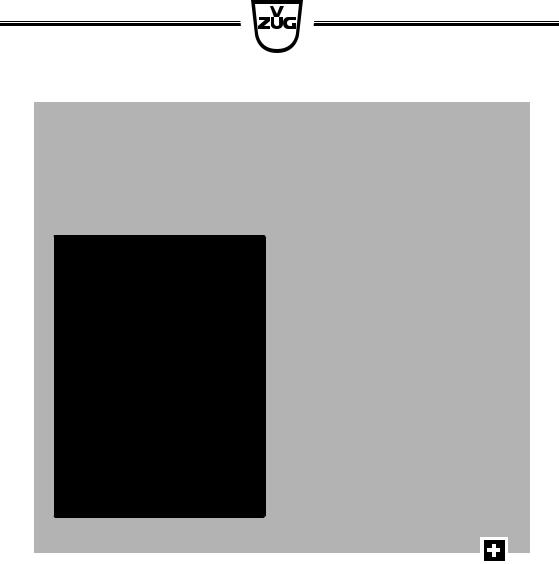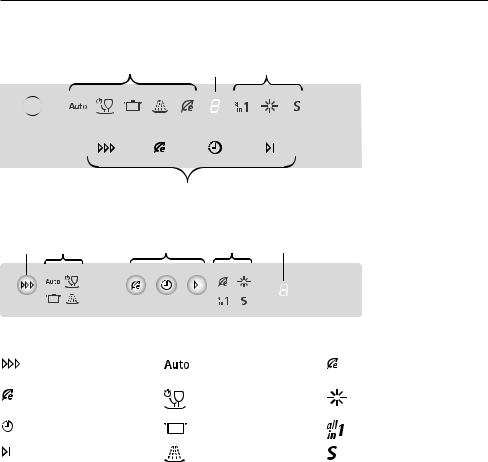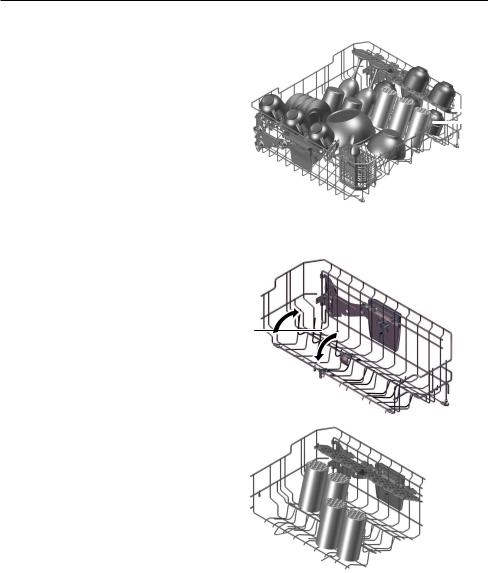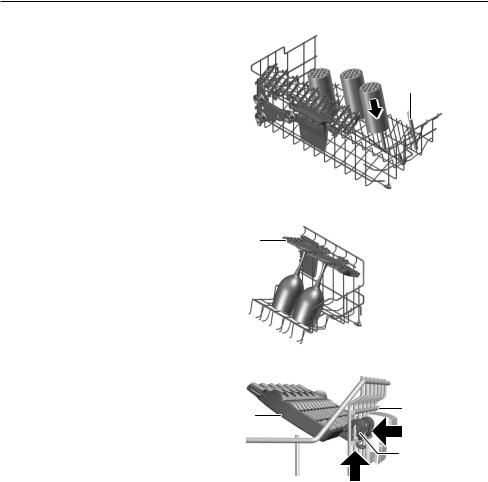V-ZUG GS60NZVI, 4107565055 User Manual

Operating instruction
Adora N fully integrated
Dishwasher

1 Safety precautions
Read the operating instruc-
tions before using the appli-
ance for the first time.
1.1 General safety precautions
▪This appliance can be used by children aged 8 and above and by persons with reduced physical, sensory or mental capabilities, or lack of experience and/or knowledge, provided they are supervised or have been instructed on the safe use of the appliance and have understood the hazards involved. Children must not play with the appliance. Cleaning and user maintenance shall not be undertaken by children without supervision.
▪If an appliance is not equipped with a mains cable and a plug or other means for disconnecting from the mains with a contact opening on each pole complying with the conditions of overvoltage category III for full isolation, an isolating device must be incorporated into the permanently installed electrical in-
© V-ZUG Ltd, CH-6301 Zug, 2017
stallation in accordance with the installation regulations.
▪If the mains cable of this appliance is damaged, it must be replaced by the manufacturer or its Customer Services or a similarly qualified person in order to avoid hazard.
1.2 Appliance-specific safety precautions
▪Never use a steam cleaner to clean the appliance.
▪If the appliance is installed on a carpeted floor ensure that the ventilation openings on the base of the appliance are not obstructed.
▪Only leave the appliance door open in the at-rest position. An open appliance door poses a danger of tripping or injury. Do not sit or rest on the appliance door or use it as a storage surface.
▪CAUTION: Knives and other items with sharp points must be placed with the point downwards or placed horizontally in the basket.
▪CAUTION: Do not drop or insert knives, forks or other
2

1 Safety precautions
sharp items in the opening of the door lock.
▪No detergent must enter the opening of the door lock. This can cause the door lock to malfunction.
▪The appliance is only suitable for washing household dishes and cutlery with water and standard dishwasher detergent. The appliance is for use in the home and for the intended purpose only. No liability is assumed for any damage caused by improper or incorrect use.
▪Capacity: 13 international place settings
▪This appliance is designed to be used for household and similar purposes such as: staff kitchens in shops, offices and other commercial premises; agricultural properties; by customers in hotels, motels and other residential facilities; in bed-and- breakfast hotels.
1.3Correct use
▪Any repairs, modifications or manipulations to the appliance, especially any electrically live parts, may only be carried out by the manufacturer, its Customer Services or a similarly qualified person. Repairs if carried out incorrectly may cause serious injury, damage to the appliance and fittings, as well as affect the functioning of the appliance. If the appliance is not working properly or in case of a repair order, follow the instructions given in the «Service & Support» section. Please contact our Customer Services if necessary.
1.4Instructions for use
Switching off the power to the appliance disables the built-in overflow protection system.
Dishwasher detergents are strongly alkaline. They can be extremely dangerous if swallowed. Avoid contact with the skin and eyes and keep children away from the dishwasher when the door is open. Check that the detergent receptable is empty after completion of the wash cycle.
▪If the appliance is visibly damaged, do not use it. Contact our Customer Services.
▪If the appliance is not operating properly, disconnect it from the power supply immediately.
▪Use original spare parts only.
▪Retain these operating instructions for future reference.
▪Avoid opening the appliance door unnecessarily during operation. The dishes and water may be hot – scalding hazard! The steam that escapes can dam-
3

1 Safety precautions
age wood combination fascias. Spectacles can steam up, impairing your vision.
▪Do not wash objects that are soiled with inflammable or corrosive solvent, paint, wax, chemicals (acids or alkaline solutions) or iron chippings or that can shed fibres in the appliance.
▪Packaging material, e.g. plastic film and polystyrene, can be dangerous for children. Danger of suffocation! Keep packaging material away from children.
1.5 Transport and
installation
FRONT
Do not tilt more than 90° to
the right!
Transport the appliance in an upright position only! Transporting it in any other position will result in damage to the appliance! When carried carefully without being shaken, the appliance may be tilted a maximum of 90° to the left (viewed from the front).
1.6 How to avoid damaging
the appliance
▪Before closing the appliance door and starting a programme ensure that there are no foreign objects (e.g. nails or paper clips) or pets in the appliance. Foreign objects can damage parts of the appliance as well as the dishes.
▪Never fill the rinse agent reservoir or the regeneration salt reservoir with detergent! If this were to happen, however, do not operate the appliance under any circumstances, as this could cause expensive damage to it. Call Customer Services.
▪Do not lean on any part of the appliance – risk of accident!
▪Turn off the water tap during longer absences.
▪The appliance must be connected to the mains supply to ensure appliance protection (overflow protection, among other things).
4

1 Safety precautions
1.7Using for the first time
The appliance must be installed and connected to the electricity supply by a qualified fitter/electrician in accordance with the separate installation instructions.
Before operating the newly installed appliance for the first time, the following steps should be taken:
Before using for the first time
Switch on the power and turn on the water tap.
Set (see page 23) the water hardness.
Fill the salt reservoir with approximately 1.0 l water and 1 kg regeneration salt. Wipe away any excess salt on the edge of the salt reservoir.
Fill the rinse agent reservoir with rinse agent.
Run the  programme without dishes to protect the appliance from corrosion from any excess salt and to remove traces of grease left behind from the manufacturing process.
programme without dishes to protect the appliance from corrosion from any excess salt and to remove traces of grease left behind from the manufacturing process.
The  refill indicator can flash during the first few wash cycles.
refill indicator can flash during the first few wash cycles.  goes out when the salt concentration in the reservoir is evenly distributed.
goes out when the salt concentration in the reservoir is evenly distributed.
1.8 Notes on using the
operating instructions
Graphical operating instructions can be
downloaded on the internet from
www.vzug.ch.
Symbols used
Denotes important safety
precautions.
Failure to observe said precautions can result in injury or in damage to the appliance or fittings!
Validity
The product family (model number) corresponds to the first alphanumerics on the identification plate. These operating instructions apply to:
Model |
Type |
Product range |
Adora |
GS60NZVi |
41075 |
60 N |
|
|
(EURO |
|
|
60) |
|
|
Variations depending on the model are noted in the text.
Modifications
Text, diagrams and data correspond to the technical standard of the appliance at the time these operating instructions went to press. The right to make technical modifications for the purpose of the further development of the appliances is reserved.
5
Contents
1 |
Safety precautions |
2 |
|
2 |
Appliance description |
7 |
|
2.1 |
|
Construction..................................................... |
7 |
2.2 |
|
Operating and display elements.................. |
8 |
3 |
Programme overview |
9 |
|
3.1 |
|
Programme ...................................................... |
9 |
3.2 |
|
Additional functions ........................................ |
9 |
4 |
Operation |
10 |
|
4.1 |
|
Preparing the appliance ............................. |
10 |
4.2 |
|
Dish washing tips......................................... |
10 |
4.3 |
|
Loading tips for the upper basket ............ |
11 |
4.4 |
|
Loading tips for the lower basket ............. |
13 |
4.5 |
|
Detergent....................................................... |
16 |
4.6 |
|
Selecting a programme .............................. |
18 |
4.7 |
|
Delayed start................................................. |
19 |
4.8 |
|
Interrupting a programme .......................... |
20 |
4.9 |
|
Aborting a programme before time.......... |
20 |
4.10 |
End of programme ...................................... |
21 |
|
5 |
User settings |
22 |
|
5.1 |
|
Overview of user settings........................... |
22 |
5.2 |
|
Changing user settings............................... |
22 |
5.3 |
|
Acoustic signal ............................................. |
23 |
5.4 |
|
All in 1............................................................ |
23 |
5.5 |
|
Water hardness ............................................ |
23 |
5.6 |
|
Rinse agent dosage .................................... |
23 |
5.7 |
|
DryPlus........................................................... |
24 |
5.8 |
|
RinsePlus....................................................... |
24 |
5.9 |
|
Hot water connection .................................. |
24 |
5.10 |
Automatic standby....................................... |
24 |
|
5.11 |
Factory setting.............................................. |
24 |
|
6 |
Care and maintenance |
25 |
|
6.1 |
|
Cleaning the interior and exterior ............. |
25 |
6.2 |
|
Cleaning the spray arms ............................ |
25 |
6.3 |
|
Cleaning the filter system........................... |
26 |
6.4 |
|
Refilling with regeneration salt .................. |
26 |
6.5 |
|
Filling with rinse agent ................................ |
27 |
7 |
Trouble-shooting |
28 |
|
7.1 |
|
Error messages............................................ |
28 |
7.2 |
|
Other possible problems............................ |
30 |
7.3 |
|
Unsatisfactory washing results.................. |
30 |
7.4 |
|
In the event of a power failure................... |
31 |
8 Accessories and spare parts |
32 |
||
9 |
Technical data |
34 |
9.1 |
Consumption data ........................................ |
35 |
9.2 |
Note for testing institutes ............................ |
35 |
9.3 |
Noise measurement ..................................... |
35 |
10 |
Disposal |
36 |
11 |
Notes |
37 |
6

2 Appliance description
2.1Construction
|
|
|
|
|
|
|
|
|
|
|
1 |
Baskets |
|
|
|
|
|
|
|
|
|
|
|
2 |
Spray arms |
|
|
|
|
|
|
|
|
|
|
|
3 |
Cutlery basket |
|
|
|
|
|
1 |
4 |
Rinse agent reservoir |
|||||
|
|
|
|
|||||||||
|
|
|
|
|
|
|
|
|
|
|
||
|
|
|
|
|
|
|
|
|
|
2 |
5 |
Operating and display elements * |
|
|
|
|
|
|
|
|
|
||||
9 |
|
|
|
|
|
|
|
|
|
2 |
6 |
Quick operating instructions |
|
|
|
|
|
|
|
|
|
||||
|
|
|
|
|
|
|
|
|
1 |
|||
|
|
|
|
|
|
|
|
|
||||
8 |
|
|
|
|
|
|
|
|
7 |
Detergent dispenser |
||
|
|
|
||||||||||
|
|
|
|
|
|
|
|
|
||||
|
|
|
|
|
|
|
|
|
|
|||
|
|
|
|
|
|
|
|
3 |
||||
|
|
|
|
|
|
|||||||
|
|
|
|
|
|
|
|
|
|
|
8 |
Salt reservoir |
7 |
|
|
|
|
|
|
4 |
9 |
Filter system |
|||
|
|
|
||||||||||
|
|
|
|
|
|
|
|
|
|
|
|
|
|
|
|
|
|
|
|
|
|
|
|
|
|
6 |
|
|
|
5 |
|
|
|
||
|
|
|
|
Integrated appliances
(operating elements are located on the outside of the appliance door): 10 Door handle
11 Operating and display elements
10
11
Fully integrated and design integrated appliances
(operating elements are located on the inside of the appliance door): 10 Door handle
11 Operation indicator on glass panel *
12 Function light *
11 

 10
10
12
* Depending on model
7

2 Appliance description
2.2Operating and display elements
Integrated appliances:
2 |
4 |
3 |
|
|
|
|
|
|
|
|
|
|
|
|
|
|
|
|
|
1
Fully integrated and design integrated appliances:
1 |
2 |
1 |
3 |
4 |
||
|
|
|
|
|
|
|
|
|
|
|
|
|
|
|
|
|
|
|
|
|
1 |
Buttons |
2 |
|
Programme symbols |
3 |
Additional function sym- |
|
|
|
|
|
|
bols /Indicator symbols |
|
Programme selec- |
|
|
Automatic |
|
Energy saving |
|
tion |
|
|
|
|
|
|
Eco programme |
|
|
Quick wash/ |
|
Rinse agent |
|
|
|
|
Glass care |
|
refill indicator |
|
Delayed start |
|
|
Intensive |
|
«All in 1» detergent |
|
|
|
|
|||
|
End of programme |
|
|
Pre-rinsing |
|
Salt refill indicator |
4 |
Display |
Acoustic signal |
Function light |
|||
|
|
(depending on model) |
(depending on model) |
|||
▪ |
Delayed start |
An acoustic signal is emit- |
▪ Illuminates during the pro- |
|||
▪ |
Error messages |
ted at the end of the pro- |
|
gramme sequence. |
||
|
|
gramme and in the event |
▪ Flashes during the final dry- |
|||
|
|
of a malfunction. |
|
ing phase. |
||
|
|
|
|
|
|
|
8

3 Programme overview
3 Programme overview
3.1Programme
Programme time and energy consumption can be reduced by selecting the  additional function.
additional function.
Eco programme: The most efficient programme in terms of water and energy consumption for normally dirty dishes (declaration programme).
Automatic: Optimum cleaning with minimal water and energy consumption. Not for burnt-on or dried leftovers.
Quick wash/Glass care: For slightly dirty dishes such as drinks glasses or coffee cups and saucers. Not suitable for slowly dissolving tabs.
Intensive: For very dirty dishes, particularly with starchy leftovers (mashed potato, rice etc.).
Pre-rinsing: Prevents dirt drying on if the wash programme is not going to be started until later.
3.2Additional functions
Energy saving: The rinsing temperature is reduced by 5 °C for around 10 % less energy consumption Gentle on glasses.
Delayed start: Allows you to wash during off-peak hours (e.g. at off-peak electricity rates). A delayed start of between 1 and 9 hours can be set.
9

4 Operation
4 |
Operation |
4.1 |
Preparing the appliance |
Remove any coarse or hard pieces of food or foreign objects (such as toothpicks) left on the dishes.
Load the baskets. After loading, check that the spray arms can turn freely.
4.2 Dish washing tips
General notes
▪Do not overload the baskets.
▪Dishes, pots and pans with heavily burned-on food debris stuck to them should be soaked in water first.
▪Load beverage and food containers such as cups, glasses, pots, etc. with the opening facing downwards so that the water can drain off.
▪When loading, ensure glasses do not touch so as to prevent damage and water spots.
▪When cleaning range hood grease filters, select the  programme and use the maximum amount of detergent.
programme and use the maximum amount of detergent.
Dishes
Not all tableand kitchenware are dishwasher safe.
▪Clean wooden or plastic parts that are sensitive to damage from heat and detergent suds by hand.
▪Pottery has a tendency to crack or chip.
▪The printing on glass and porcelain is hard-wearing only to a point and eventually over time can wear off.
▪Glassware, depending on the type and the detergent being used, can become cloudy. Check with your glassware supplier as to whether your glassware is dishwasher safe.
▪Stress and tension in thick cut crystal glasses and dishes can cause cracking.
▪Do not wash dishes with adhesive labels on them. Adhesive labels can come off and clog up the filter system.
▪Objects made of silver, copper and tin tend to discolour, turning brown or black.
▪Spots tend to form on aluminium. Wash aluminium separately or by hand.
10

4 Operation
4.3Loading tips for the upper basket
Arrange smaller items such as saucers,
|
glasses, cups and dishes. |
|
|
|
|
|
If using the fold-down racks 1, stagger the |
|
|
|
|
|
items. |
|
|
|
|
|
Rest glasses on the fold-down glass holder |
|
|
1 |
|
|
|
||||
|
2. |
|
|
2 |
|
|
|
|
|||
Glass holder
Particularly suitable for tall glasses.
Push the glass holders 1 gently down or, alternatively, pull them up until they engage.
1
11

4 Operation
Easy prongs
For placing drinking glasses, baby bottles, vases and carafes anywhere in the basket.
Put easy prong 1 over basket prongs.
Use 2 easy prongs for wider vessels.
Racks
The racks 1 can also be used as glass holders. Remove the racks to accommodate tall glasses.
Dismantling/Adjusting the height of the racks
Push the rack 1 up by the hooks 2.
Push the rack inward and then out.
Hook the rack in the higher position 3, if required.
1
1
1
3
2.
1.2
12
